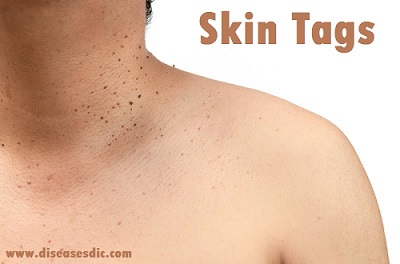Definition
Skin tags are common, acquired benign skin growths that resemble a small, soft balloon suspended on a slender stalk. Skin tags are harmless growths that can vary in number from one to hundreds. Males and females are equally prone to developing skin tags. Obesity seems to be associated with skin tag development. Although some skin tags may fall off spontaneously, most persist once formed. The medical name for skin tag is acrochordon. Some people call them “skin tabs.”
Epidemiology
Frequency
Acrochordons have been reported to have an incidence of 46% in the general population.
Sex
An equal prevalence of acrochordons exists in males and females.
Age
When present, acrochordons increase in frequency up through the fifth decade. As many as 59% of persons may have acrochordons by the time they are aged 70 years.
Causes
- Skin tags are very common and generally occur after midlife. They are said to be caused by bunches of collagen and blood vessels which are trapped inside thicker bits of skin.
- They are believed to be the result of skin rubbing against skin. That is why they are generally found in skin creases and folds.
Symptoms of Skin tags
It is typically flesh-colored or may appear brown in light-skinned individuals. They may be smooth or wrinkled and range in size from very tiny (1 mm) to approximately the size of a grape. Although it is usually possible to recognize a stalk that attaches the skin tag to the underlying skin, very small skin tags may appear as raised bumps on the skin.
If a skin tag is twisted on its blood supply it may turn red or black. Skin tags may bleed if caught on clothing or are otherwise torn. Skin tags are not typically painful and are not associated with any particular skin conditions or symptoms. However, people who are prone to diabetes and have a skin condition called acanthosis nigricans often have associated skin tags, suggesting that factors which make one prone to diabetes may be operative in the development of skin tags.
Diagnosis and test
Our doctor can diagnose this condition by looking at your skin. Sometimes, a skin biopsy is done.
Treatment
As it is usually harmless, people tend to have them removed for aesthetic or cosmetic reasons.
Sometimes large ones, especially in areas where they may rub against something, such as clothing, jewelry or skin, may be removed because the area becomes frequently irritated. An individual may have a large skin tag removed from his face or under her arms in order to make shaving easier.
The following procedures may be used to remove skin tags:
Cauterization- The skin tag is burned off using electrolysis (heat is used to remove them)
Cryosurgery- The skin tag is frozen off using a probe containing liquid nitrogen
Ligation- The blood supply to the skin tag is interrupted
Excision- The skin tag is removed with a scalpel (it is cut out)
These procedures should be performed only by a dermatologist (specialist skin doctor) or similarly trained medical professional.
Risks associated with skin tag removal
Skin tag removal is a low-risk procedure. However, they often bleed freely when removed, requiring pressure and monitoring during the procedure. Sometimes coagulation with silver nitrate or electrocautery is necessary.
In rare cases, you may experience heavy bleeding or develop an infection after the surgery. You can lower your risk for complications by telling your doctor about any prescription or over-the-counter medications you’re taking, since some drugs and herbal supplements can make you bleed more after skin tag removal.
It’s also important to follow your doctor’s instructions on how to care for the area where your skin tags were removed. This will reduce your risk of getting an infection after the procedure. You should never try to remove skin tags at home. Without a doctor and a sterile environment, the risk for excessive bleeding and infection increases.
Skin tags complications
Complications of surgical skin tag removal
The complications of the entire procedure are few but they are there. Some of them are:
- Scarring can occur if the doctor does not remove the skin tag carefully.
- Some of the real skin tissue can come off as well but this rarely happens if you go to an experienced doctor.
- Some irritation and rash can occur on the area where the skin tag used to be after the surgery.
- Sometime, a certain nerve can grow into the skin tag. This is the rarest of cases but it can happen. When the skin tag is cut off, even by a surgical procedure, you are still in pain because part of the nerve has also been cut off with it.
Prevention of Skin tags
It is not possible to completely prevent the development of skin tags, although weight loss may be helpful in this regard.

